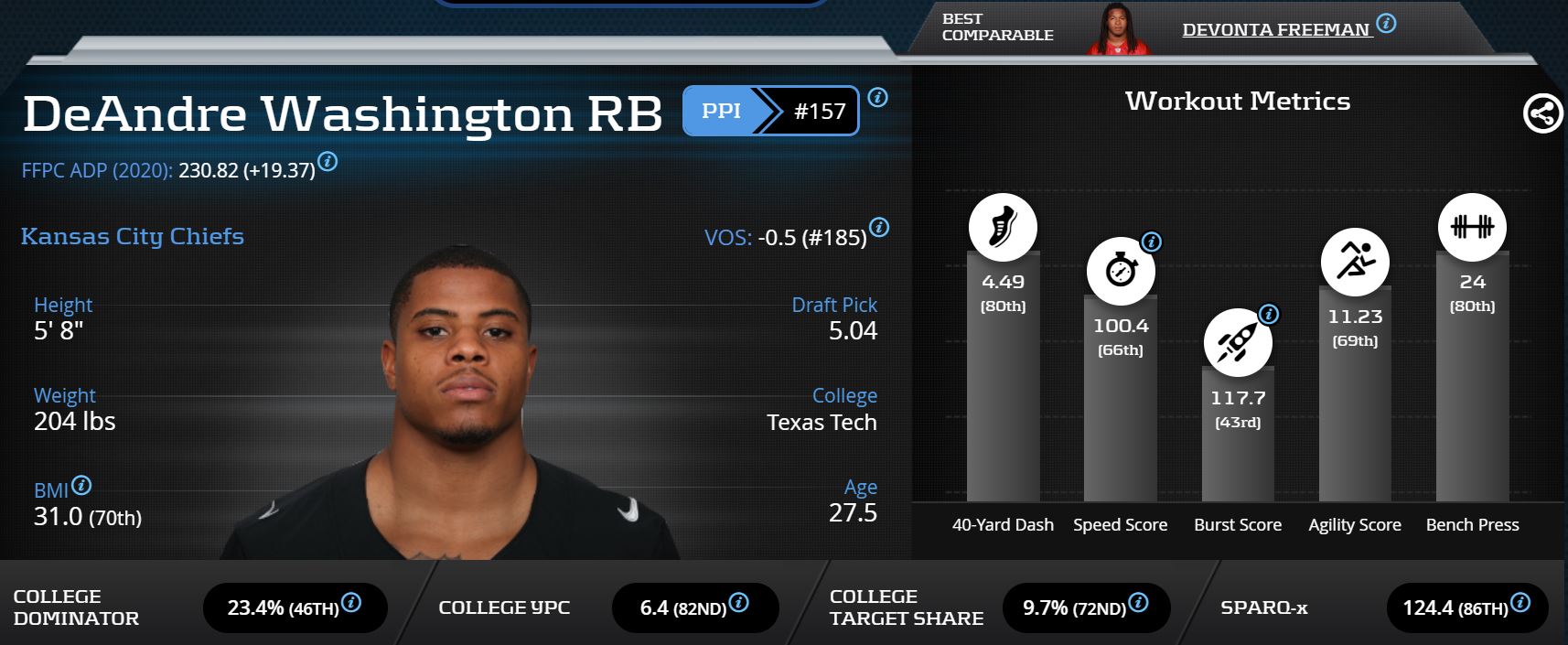The upside for Clyde Edwards-Helaire is tantalizing for 2020 being in a Patrick Mahomes-led offense. The problem is that he was already being drafted close to his ceiling. Now with Damien Williams opting out, he’s been vaulted into the top-five alongside Christian McCaffrey, Saquon Barkley, Alvin Kamara, and Ezekiel Elliott. Using PlayerProfiler’s advanced stats and metrics can tell us whether this is a good idea.
Prospect Profile and Production
At 5-7, 207-pounds with a 92.5 (36th-percentile among qualified running backs) Speed Score on a 4.60 (47th-percentile) 40-Yard Dash, Clyde Edwards-Helaire does not possess a workhorse back profile. The group of running backs he’s now being drafted with have an average weight of 219.5-pounds, they all ran below sub 4.5 40-Yard Dashes, and none posted a Speed Score lower than 100.3. In addition, his only season with viable college production came last year. Nick Brossette saw more carries, targets, and receptions in 2018. Helaire was fourth on the depth chart in 2017 behind Derrius Guice, Darrel Williams, and Brossette.
While Helaire’s 2019 season was great, he still posted a mere 10.2-percent (76th-percentile) Target Share in that offense as the team’s No. 4 option behind Ja’Marr Chase, Justin Jefferson, and Terrace Marshall. He only out-targeted undrafted rookie Thaddeus Moss 58 to 51. Of the other running backs now being drafted around Helaire, only Ezekiel Elliott did not have a college season with a larger Target Share.
2020 Season Outlook
Now that Damien Williams has opted out, the narrative is that Clyde Edwards-Helaire becomes a three-down workhorse despite his build and profile. There’s also the presence of DeAndre Washington, who has the same build with a better 40-Yard Dash and Speed Score.
The consensus is that Helaire will now see all the early-down work while catching 70-plus passes in this offense because he is tethered to Andy Reid. In reality, fantasy gamers are tethered to the memories of Williams and Kareem Hunt streaking down the sideline on wheel routes. While he now has an easier path to 200 carries, the notion that CEH will command all these targets is off. Only once since 2015 have the Chiefs reached even an average team Target Share for running backs despite the gun-shy Alex Smith being under center for three of those seasons.
People may point to LeSean McCoy as a comparison to what Helaire can do despite the fact that McCoy was an elite college producer at Pitt and entered the NFL at age 20. Still, he only surpassed 69 targets and 54 receptions one time in his Eagles career. His 16-game averages after becoming the featured back were 71 targets and 56 receptions.
Check out Clyde Edwards-Helaire’s 2020 Projection on PlayerProfiler’s “World Famous” Draft Kit:
The next argument is the Brian Westbrook comparison. Andy Reid himself said Helaire looks like a better version of Westbrook. While that is lofty praise, we need to look at Westbrook’s work in a vacuum. While being the featured back for the Eagles from 2004 to 2008, he averaged 13.8 games played, 216.8 carries, 983 yards, seven touchdowns, 96 targets, 71 receptions, and six touchdowns. There is, however, a distinct difference between those Eagles teams and this Chiefs team. Here is a list of the top three wide receivers and the number one tight end from those Eagles teams;
2004 – New signed Terrell Owens, Todd Pinkston, Freddie Mitchell, L.J. Smith
2005 – Seven games of Terrell Owens, Greg Lewis, rookie Reggie Brown, L.J. Smith
2006 – Donte Stallworth, Reggie Brown, Hank Baskett, L.J. Smith
2007 – Kevin Kurtis, Reggie Brown, Jason Avant, L.J. Smith
2008 – Rookie DeSean Jackson, Kevin Kurtis, Jason Avant, L.J. Smith
The Patrick Mahomes-led Chiefs team features Travis Kelce, Tyreek Hill, Sammy Watkins, Demarcus Robinson, and now Mecole Hardman. The combination of explosive weapons and the unbelievable talent/play of Mahomes has led to a mere 3.3-percent checkdown rate. Helaire projects, at best, to be the No. 3 option on this team, but how will he take away from Watkins and Hardman? Andy Reid would have to scheme up lots of plays specifically for Helaire in order for him to reach the lofty target and reception totals that are now expected.
Conclusion
The idea that Clyde Edwards-Helaire should be drafted before Derrick Henry, Alvin Kamara, and Nick Chubb seems like a stretch. His ceiling for touches is around 250 for the season. That’s the baseline for those other three players, not to mention Christian McCaffrey, Saquon Barkley, Ezekiel Elliott, and Dalvin Cook. We have learned over the years that the number one factor for a fantasy running back is volume, and Helaire does not possess the same volume upside. There are even arguments that can be made where players such as James Conner and Chris Carson can see over 70 touches more for the season while still being in prolific offenses.
It seems the argument for Helaire is mainly situation-based. DeAndre Washington is there with a similar profile and has already had productive games in the NFL. Darrel Williams could also take away goal line work. CEH should still be drafted as an RB1 for the 2020 season, but Buyer Beware.




